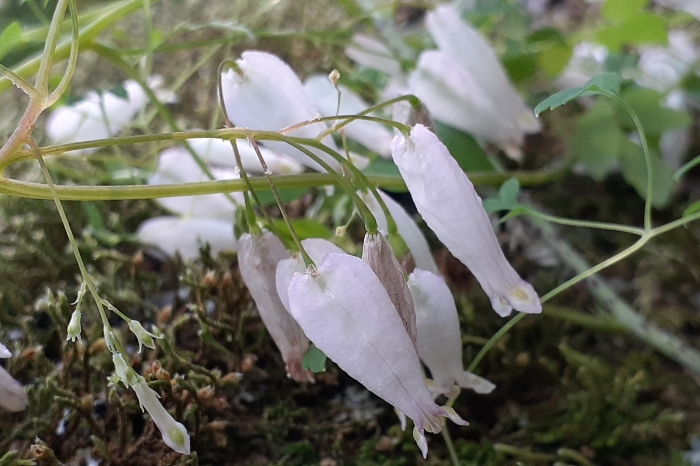Allegheny Vine
(Adlumia fungosa)
Allegheny Vine (Adlumia fungosa)
/
/

Quinten Wiegersma
CC BY 4.0
Image By:
Quinten Wiegersma
Recorded By:
Copyright:
CC BY 4.0
Copyright Notice:
Photo by: Quinten Wiegersma | License Type: CC BY 4.0 | License URL: http://creativecommons.org/licenses/by/4.0/ | Rights Holder: Quinten Wiegersma | Publisher: iNaturalist | Date Created: 2021-08-23T21:11:26Z |























Estimated Native Range
Summary
Adlumia fungosa, commonly known as Allegheny Vine or Climbing Fumitory, is a biennial or short-lived perennial herb native to moist woodlands and forest edges in Eastern North America. It is characterized by its delicate, twining habit and can reach lengths of up to 15 feet (4.5 meters), often climbing over shrubs and other supports. The leaves are finely dissected, giving them a feathery appearance, and are capable of clinging to supports with their prehensile qualities. From mid-summer to early fall, Allegheny Vine produces clusters of small, tubular flowers that are white to pinkish in color and can be quite showy.
Allegheny Vine is valued for its ability to cover unsightly areas quickly, making it a good choice for naturalizing in shaded areas. It thrives in moist, well-drained soils rich in organic matter and can be grown in full sun to full shade, though it prefers some shade in hotter climates. While it is not commonly used in formal garden settings, it can be an attractive addition to woodland gardens or naturalized areas. Gardeners should be aware that it can self-seed and become weedy in optimal conditions. It is not known for significant disease or pest problems, but its aggressive growth may require management to prevent it from overwhelming other plants.CC BY-SA 4.0
Allegheny Vine is valued for its ability to cover unsightly areas quickly, making it a good choice for naturalizing in shaded areas. It thrives in moist, well-drained soils rich in organic matter and can be grown in full sun to full shade, though it prefers some shade in hotter climates. While it is not commonly used in formal garden settings, it can be an attractive addition to woodland gardens or naturalized areas. Gardeners should be aware that it can self-seed and become weedy in optimal conditions. It is not known for significant disease or pest problems, but its aggressive growth may require management to prevent it from overwhelming other plants.CC BY-SA 4.0
Plant Description
- Plant Type: Vine, Herb
- Height: 7-10 feet
- Width: 4-10 feet
- Growth Rate: Moderate
- Flower Color: White
- Flowering Season: Summer
- Leaf Retention: Deciduous
Growth Requirements
- Sun: Full Sun, Part Shade, Full Shade
- Water: Medium
- Drainage: Medium
Common Uses
Deer Resistant, Low Maintenance
Natural Habitat
Moist woodlands and forest edges
Other Names
Common Names: Climbing Fumitory, Mountain-Fringe, Canary Vine, Adlumie Fongueuse, Allegheny-Vine
Scientific Names: , Adlumia fungosa, Adlumia cirrhosa, Fumaria fungosa, Corydalis fungosa, Fumaria recta, Adlumia cirrhosa var. alba, Adlumia cirrhosa var. elatior, Adlumia cirrhosa var. rosea, Adlumia cirrhosa var. rupestris
GBIF Accepted Name: Adlumia fungosa (Aiton) Greene ex Britton, Stern & Poggenb.